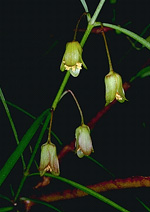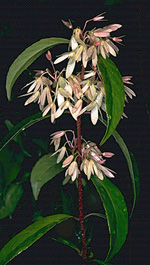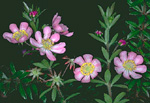 |
This is a small, southern family most diverse in Australia and Papua New Guinea but also in South-East Asia, South Africa and South America. Trees or shrubs of the Cunoniaceae are common in forests of eastern and south-western Australia, often in relatively wet forests and at high (but not alpine) altitudes.
Characteristic features of the family Cunoniaceae in Australia include: - trees, shrubs or woody twining climbers, with opposite or whorled leaves which are usually compound (trifoliolate or pinnate)
- leaves or leaflets usually neatly and regularly toothed, often with prominent, interpetiolar stipules
- flowers in terminal or axillary racemes, panicles or heads, without bracts, regular, with 3-6 petals and sepals (or petals absent) and 8-10 stamens inserted on a prominent disc adjacent to sepals
- fruit a capsule or fleshy drupe developed from a superior ovary of 2-6 free or fused carpels
Description
Evergreen trees, or shrubs, or woody or herbaceous vines climbing by twining stems. Internal secretions not obvious. Plants glabrous or rarely with simple, glandular or non-glandular, unicellular hairs. Leaves opposite, rarely alternate and spiral, or in whorls of 6, petiolate or sessile. Stipules absent, or present and interpetiolar, scale-like or membranous, falling off early, stipellae absent. Domatia absent or consisting of pits, pockets or hair tufts in the vein angles. Lamina simple or once compound, ternate or imparipinnate, symmetric; lamina/leaflets filiform, acicular, subulate, linear, lanceolate, ovate, elliptic or oblong; base cuneate, attenuate, or rarely cordate; margins serrate, ±flat; venation pinnate, with the midrib conspicuous, and the tertiary venation not reticulate; surfaces not punctate; herbaceous or leathery. Usually with all the flowers bisexual, or rarely with male and female flowers also present on the same plant, or with male and female flowers on separate plants. Inflorescences terminal or axillary, consisting of capitula, racemes, panicles or solitary flowers. Bracts and bracteoles absent. Pollination by ?wind. Flowers odourless or fragrant; sessile or stalked. Floral disc present; nectaries absent or present on the disc. Perianth regular, of 2 dissimilar whorls or of 1 whorl only or all whorls ±similar. Calyx segments free or fused, with (3–) 4–5 (–10) sepals or lobes, imbricate or valvate in bud; calyx cup-shaped, funnel-shaped or tubular, herbaceous. Corolla segments free or fused, with (0–) 4–5 (–10) petals or lobes, alternating with the sepals or calyx lobes, imbricate in bud; corolla wheel-shaped or bell-shaped, white or pink, without contrasting markings, membranous; claws absent; lobes ±entire. Fertile stamens 8–10, rarely more, opposite to the sepals or calyx lobes, free of the corolla, free of the ovary and style, distinct from each other, all ±equal. Anthers dorsifixed, versatile or not versatile, opening terminally by pores or inwards by short slits or longitudinal slits; 2-celled. Ovary superior and sessile or part-inferior. Carpels 2–6, free or fused; ovary with 2–6 locules. Style terminal, single and unbranched, or branching from the base. Ovules 1–numerous per locule, sessile; placentation apical or axile. Fruit a dry, dehiscent septicidal or loculicidal capsule, or a nut, or a fleshy (rare), indehiscent berry or drupe; the perianth on the maturing fruit deciduous or dry and persistent. Disseminule macro-surface featureless, winged or with straight hairs, white, cream or brown. Seeds 1–numerous per fruit. Aril absent. Cotyledons 2. Embryo straight.
(Note: this description has been generated from the coded data compiled for the key. Any errors in the key data will be reflected in the descriptions.)
A treatment of the family Cunoniaceae has not yet been published in the
Flora of Australia. It will appear in Volume 10.
Australian genera of Cunoniaceae (as recognised for the Flora of Australia)
Acrophyllum
Acsmithia
Anodopetalum
Aphanopetalum
Bauera
Caldcluvia
Callicoma
Ceratopetalum
Geissois
Gillbeea
Pseudoweinmannia
Pullea
Schizomeria
Vesselowskya

|
  |

Acrophyllum australe (flowers)
Photo: P.Ollerenshaw © ANBG

Aphanopetalum clematideum (flowers)
Photo: M.Fagg © ANBG

Aphanopetalum resinosum (flowers)
Photo: M.Fagg © ANBG

Bauera rubioides (flowers)
Photo: M.Fagg © ANBG

|
 |
|